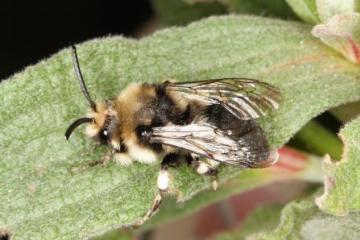Cuckoo bee Melecta albifrons
Melecta albifrons male,
© Peter Harvey
The bee
Melecta albifrons is a cuckoo bee to look out for in spring, especially if you have a nesting aggregation of the Spring or Hairy-footed Flower Bee
Anthophora plumipes. It is a cleptoparasite or cuckoo bee of
Anthophora - this means that the bee (female) goes into an
Anthophora burrow and lays its egg with the pollen food supply gathered by
Anthophora. When the
Melecta egg hatches the larva feeds up on the food supply intended for the
Anthophora larva, pupates and emerges next year instead of the host. It is found throughout much of southern England, with an apparent bias towards the south-east. There is at least one old record for south Wales. Any records of the host
Anthophora bee or the cleptoparasite
Melecta bee would be very welcome.
Melecta is a distinctive spring bee, about the same size as
Anthophora, with the head and body entirely black in the female except for a pair of lateral patches of white appressed hairs on most of the gastral tergites (top surface of the abdomen) and on the legs. However, in some individuals, these patches are darker, so that these are not so obvious. The male has more white or yellowish white hairs, on the head and thorax.
We would welcome any observations of Melecta albifrons during the spring, and any records from outside Essex will also be submitted to the national recording scheme run by BWARS  (the Bee, Wasp and Ant Recording Society).
(the Bee, Wasp and Ant Recording Society).
![]() (the Bee, Wasp and Ant Recording Society).
(the Bee, Wasp and Ant Recording Society).


















